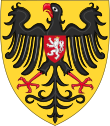
Back Karl IV. (HRR) ALS Carlos IV d'o Sacro Imperio Romano Chermanico AN كارل الرابع Arabic كارل الرابع ARZ Carlos IV de Luxemburgu AST دؤردونجو کارل AZB Карл IV (Изге Рим империяһы императоры) Bashkir Карл IV Люксембургскі Byelorussian Карл IV Люксэмбурскі BE-X-OLD Карл IV (Свещена Римска империя) Bulgarian
| Charles IV | |
|---|---|
 Charles IV in the Votive Panel of Jan Očko of Vlašim | |
| Holy Roman Emperor King of Italy | |
| Reign | 1355 – 29 November 1378 |
| Coronation | |
| Predecessor | Louis IV |
| Successor | Sigismund |
| King of the Romans King of Germany | |
| Reign | 11 July 1346 – 29 November 1378 |
| Coronation | 26 November 1346, Bonn |
| Predecessor | Louis IV |
| Successor | Wenceslaus |
| King of Bohemia | |
| Reign | 26 August 1346 – 29 November 1378 |
| Coronation | 2 September 1347, Prague |
| Predecessor | John |
| Successor | Wenceslaus IV |
| Born | 14 May 1316 Prague, Kingdom of Bohemia |
| Died | 29 November 1378 (aged 62) Prague, Kingdom of Bohemia |
| Burial | St. Vitus Cathedral, Prague |
| Spouses | |
| Issue | |
| House | Luxembourg |
| Father | John of Bohemia |
| Mother | Elisabeth of Bohemia |


Charles IV (Czech: Karel IV.; German: Karl IV.; Latin: Carolus IV; 14 May 1316 – 29 November 1378[1]), also known as Charles of Luxembourg, born Wenceslaus (Czech: Václav, German: Wenzel),[2] was Holy Roman Emperor from 1355 until his death in 1378. He was elected King of Germany (King of the Romans) in 1346 and became King of Bohemia that same year. He was a member of the House of Luxembourg from his father's side and the Bohemian House of Přemyslid from his mother's side; he emphasized the latter due to his lifelong affinity for the Bohemian side of his inheritance, and also because his direct ancestors in the Přemyslid line included two saints.[3][4]
He was the eldest son and heir of John of Bohemia, King of Bohemia and Count of Luxembourg, who died at the Battle of Crécy on 26 August 1346. His mother, Elizabeth, Queen of Bohemia, was the sister of Wenceslaus III, King of Bohemia and Poland, the last of the male Přemyslid rulers of Bohemia. Charles inherited the County of Luxembourg from his father and was elected king of the Kingdom of Bohemia. On 2 September 1347, Charles was crowned King of Bohemia.
On 11 July 1346, the prince-electors chose him as King of the Romans (rex Romanorum) in opposition to Louis IV, Holy Roman Emperor. Charles was crowned on 26 November 1346 in Bonn. After his opponent died, he was re-elected in 1349 and crowned King of the Romans. In 1355, he was crowned King of Italy and Holy Roman Emperor. With his coronation as King of Burgundy in 1365, he became the personal ruler of all the kingdoms of the Holy Roman Empire. Having played a key part in the political and cultural history of the Kingdom of Bohemia, he remains a popular historical figure in the Czech Republic. [citation needed]
The Golden Bull of 1356 marked a structural change in the politics of the Holy Roman Empire. Several aspects of his legacy remain a contentious matter though. The image of Charles as a wise, pious, peace-loving king (partly constructed by Charles himself) has proved influential until this day, supported by several artistic or scholarly projects produced during Charles's reign or afterwards.
- ^ Karl IV. In: Hans Herzfeld [de] (1960): Geschichte in Gestalten (History in figures), vol. 2: F–K. Das Fischer Lexikon [de] 38, Frankfurt 1963, p. 294
- ^ Kavka, František (1998). "Chapter 3: Politics and culture under Charles IV". In Teich, Mikuláš (ed.). Bohemia in History. Cambridge University Press. p. 60. ISBN 0-521-43155-7.
- ^ Mahoney, William (2011). The history of the Czech Republic and Slovakia. Greenwood. p. 50. ISBN 978-0313363054.
- ^ Agnew, Hugh (2004). The Czechs and the lands of the Bohemian crown. Hoover Institution Press. pp. 32. ISBN 978-0817944926.
© MMXXIII Rich X Search. We shall prevail. All rights reserved. Rich X Search